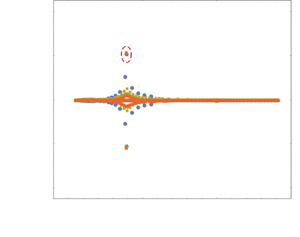Article contents
Inertio–elastic instability of a vortex column
Published online by Cambridge University Press: 28 February 2022
Abstract

We analyse the instability of a vortex column in a dilute polymer solution at large  ${{Re}}$ and
${{Re}}$ and  ${{De}}$ with
${{De}}$ with  ${{El}} = {{De}}/{{Re}}$, the elasticity number, being finite. Here,
${{El}} = {{De}}/{{Re}}$, the elasticity number, being finite. Here,  ${{Re}} = \varOmega _0 a^2/\nu$ and
${{Re}} = \varOmega _0 a^2/\nu$ and  ${{De}} = \varOmega _0 \tau$ are, respectively, the Reynolds and Deborah numbers based on the core angular velocity (
${{De}} = \varOmega _0 \tau$ are, respectively, the Reynolds and Deborah numbers based on the core angular velocity ( $\varOmega _0$), the radius of the column (
$\varOmega _0$), the radius of the column ( $a$), the total (solvent plus polymer) kinematic viscosity (
$a$), the total (solvent plus polymer) kinematic viscosity ( $\nu = (\mu _s +\mu _p)/\rho$ with
$\nu = (\mu _s +\mu _p)/\rho$ with  $\mu _s$ and
$\mu _s$ and  $\mu _p$ being the solvent and polymer contributions to the viscosity) and the polymeric relaxation time (
$\mu _p$ being the solvent and polymer contributions to the viscosity) and the polymeric relaxation time ( $\tau$). The stability of small-amplitude perturbations in this distinguished limit is governed by the elastic Rayleigh equation whose spectrum is parameterized by
$\tau$). The stability of small-amplitude perturbations in this distinguished limit is governed by the elastic Rayleigh equation whose spectrum is parameterized by  ${E} = {{El}}(1-\beta )$,
${E} = {{El}}(1-\beta )$,  $\beta$ being the ratio of the solvent to the solution viscosity. The neglect of the relaxation terms, in the said limit, implies that the polymer solution supports undamped elastic shear waves propagating relative to the base-state flow. Unlike the neutrally stable inviscid case, an instability of the vortex column arises for finite
$\beta$ being the ratio of the solvent to the solution viscosity. The neglect of the relaxation terms, in the said limit, implies that the polymer solution supports undamped elastic shear waves propagating relative to the base-state flow. Unlike the neutrally stable inviscid case, an instability of the vortex column arises for finite  ${E}$ due to a pair of elastic shear waves being driven into a resonant interaction under the differential convection by the irrotational shearing flow outside the core. An asymptotic analysis for the Rankine profile shows the absence of an elastic threshold for this instability. The growth rate is
${E}$ due to a pair of elastic shear waves being driven into a resonant interaction under the differential convection by the irrotational shearing flow outside the core. An asymptotic analysis for the Rankine profile shows the absence of an elastic threshold for this instability. The growth rate is  $O(\varOmega _0)$ for order unity
$O(\varOmega _0)$ for order unity  $E$, although it becomes transcendentally small for
$E$, although it becomes transcendentally small for  ${E} \ll 1$, being
${E} \ll 1$, being  $O(\varOmega _0 {E}^2{\rm e}^{-1/{E}^{{1}/{2}}})$. An accompanying numerical investigation shows that the instability persists for smooth monotonically decreasing vorticity profiles, provided the radial extent of the transition region (from the rotational core to the irrotational exterior) is less than a certain
$O(\varOmega _0 {E}^2{\rm e}^{-1/{E}^{{1}/{2}}})$. An accompanying numerical investigation shows that the instability persists for smooth monotonically decreasing vorticity profiles, provided the radial extent of the transition region (from the rotational core to the irrotational exterior) is less than a certain  ${E}$-dependent threshold.
${E}$-dependent threshold.
- Type
- JFM Papers
- Information
- Copyright
- © The Author(s), 2022. Published by Cambridge University Press
References
REFERENCES
- 5
- Cited by



